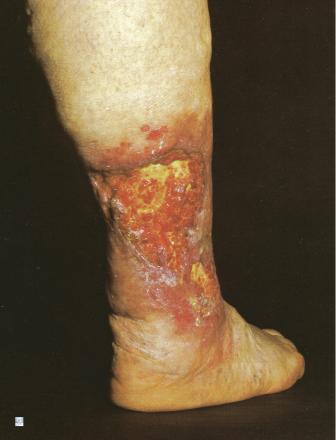Chronic Venous Ulcers
Venous leg ulcer
What are venous leg ulcers?
- Venous leg ulcers are the commonest cause of chronic, non-healing ulcers of the leg. They occur in adults of both sexes and can take a long time to heal. There are many other causes of chronic leg ulcers and proper evaluation by a medical doctor is needed to make the diagnosis.
What is the cause of venous leg ulcers?
- The vascular supply to the leg consists of blood vessels called veins:
- which return blood from the lower legs to the heart
- helped by valves that ensure that the “one-way” upward flow of blood. In many patients with venous leg ulcers, these valves do not work properly, causing blood to accumulate in the lower legs. This can lead to swelling and darkening of the skin, and eventually to the development of venous leg ulcers.
What are the risk factors for venous leg ulcers?
- Risk factors include:
- past history of a blood clot in the leg veins (deep vein thrombosis)
- lower leg injury
- varicose veins
- obesity
- smoking
- prolonged standing.
- Patients who have difficulty getting around or walking can also get venous leg ulcers because of loss of calf-muscle pump action which is important for venous blood circulation.
What are the signs and symptoms of venous leg ulcers?
- Most patients with venous leg disease complain of aching pain and swelling of their legs, especially towards the end of the day. The skin of the leg can become dark brown or red in colour, or there can be an itchy red rash with scaling and crusting. Small or large varicose veins can be seen.
- Venous leg ulcers are often located just above the ankle. They are usually wet and oozing, with a heavy discharge. They can be painful to touch or continuously.
How are venous ulcers treated?
- Once the diagnosis is confirmed, venous leg ulcers can be treated effectively by good wound care and the use of compression therapy. The latter can improve the venous flow and decrease the swelling of the legs. Compression therapy usually consists of special “elastic” bandages. The arterial blood supply of the lower limbs must be adequate (and checked to be so) before compression therapy can be used.
What is the best way to prevent venous leg disease?
- Once the leg ulcer is healed, it is important to prevent recurrence by wearing support stockings, which must be replaced every 3 to 6 months or as soon as they lose their elasticity. Other important measures include:
- good skin care
- regular exercise
- weight management
- stopping smoking
- leg elevation above the level of the heart when lying down.
Contributors:
Dr Christophe HSU – dermatologist. Geneva, Switzerland
National Skin Centre. Singapore
Category : leg ulcers - Modifie le 11.28.2009Category : problème de peau chez la personne âgée - Modifie le 11.28.2009Category : skin problems in old age - Modifie le 11.28.2009Category : ulcères de jambes - Modifie le 11.28.2009



